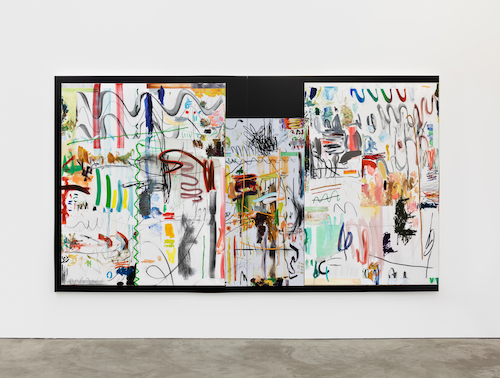
The Windowing System – as a (hyperstatic) problem by Andreas Breunig @ Nino Mier Gallery
Andreas Breunig’s The Windowing System – as a (hyperstatic) problemopening at Nino Mier Gallery presents a fine connection and indeed continuation of the Western Fine Arts tradition through the clever use of the novel “windowing” technique. By placing his canvas in geometrical constructions, the artworks, most emphatically the triad of Hi_LoRes_46, Hi_LoRes_52, and Hi_LoRes_58, immediately recollect the triptych assemblage found at the genesis of Western Fine Arts.
Concentrating on this extraordinary technique for now, consider the elevation of the artwork toward this sacred effort which mandated outstanding efforts by feudal European talents in order to be considered worthy of integration in the former European holiest of holies – the Catholic Church. Mr. Breunig’s attempt here at imbuing a new direction of sacred craftsmanship brandishes the history of Western Art with deeper insight. It clearly reveals that the subject is not sufficient in describing a historical triptych artwork, but indeed the composition’s housing itself is a continuous element of the sacredness. While this may seem self-evident with the often-opulent woodwork of historical triptychs, the elucidation here, provided by Mr. Breunig’s panels, is in the historically contemporary treatment of such craftsmanship – revealing that the entire installed work is a fruit of the Church’s sacramental planting and is intended to engender reverie upon contemplation. This insight of the permeationof the reverence of the panel paintings in the Western tradition into the material world, and not sufficiently as a narration of the sacred history insulated within the “mystical body of Christ”, can be thought of as complementing the fulfilment of the Church and its “mystical body of Christ” ethos– which is unequivocally the strongest root of Western Civilization.
But the aim of Mr. Breunig in manifesting an inner-dimension to the transcendent trajectory of Western history, which has ultimately promulgated the use of Greek symbols in mathematics and natural science across the globe as part of a tradition of mastering the objective world through the power of the mind, requires an equally comparable paean to the transcendent. Are his works up to the task of dueling with Jesus Christ? Is his aim just that: to rival? We would see such ignobility patently clear with the abstract elements veering toward dominion of the mysteries of Christianity a lathe infamous Piss Christ. But we don’t. For Mr. Breunig is too concerned with his own world and his own imaginative splendor. Aggregated inside each of his windowing systems is an exquisite playset of contemporary fine art techniques; a buffet of textures, lines, and colors, sometimes digitally rendered, organized to achieve the same exact purpose as the Church’s own triptychs: to bring wonder and awe to the salt of the earth which pass through the Cathedral’s virginity. And Mr. Breunig’s conscientious effort in his curation to provide altitude to one of his windowing system installments aims at just this wonderment.
With this exhibition, Mr. Breunig answers positively on what Western Fine Art ought to be by being able to unwrap the sacramental elements of Christian European history and its reliance on vividness to elevate the souls of its onlookers with experimental bliss. There is a preservation of Western tradition encrypted in the presentation of his own Promethean mysteries, providing an unabashed outlet and way forward for the Western man to affirm his life and continuation of his past immortal legacy of syncretizing the Western Pagan world with the Near-Eastern Hebrew God – which is with the exercise and promotion of the human imagination.

